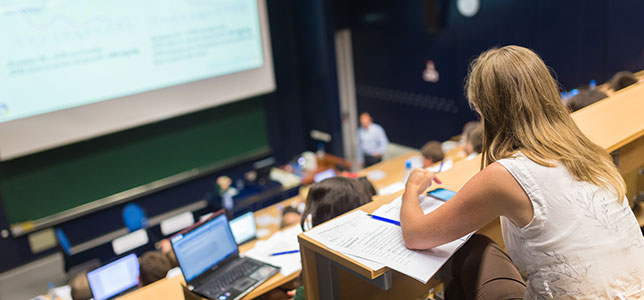Report: Reforming STEM Ed at Research Universities
- By Dian Schaffhauser
- 02/16/17

As the research on how people learn evolves, so should instructional methods for STEM undergraduate programs within colleges and universities. That's the premise of a set of case studies compiled in a publicly available report published by the Association of American Universities and the Research Corporation for Science Advancement.
The case studies profile current and past efforts to transform teaching and learning in STEM fields from the traditional lecture format and are meant to serve as a resource for department chairs and deans who are considering large-scale efforts of their own.
The case studies, written by insiders, examine programs within five institutions:
"It is possible to achieve widespread change within departments," reported Carl Wieman, a professor at Stanford University (and a Nobel Prize winner in physics), who wrote an executive summary of the initiatives at U Colorado Boulder and UBC. He noted that while "nearly all faculty can learn to use new teaching methods effectively," there's a "significant initial learning curve." Likewise, essential ingredients for success include competitive grants with "substantial funds at stake" and "explicit benefits" for faculty to participate; the expertise of "science education specialists," experts such as new Ph.D.s who can work with faculty to change specific courses; and establishment of "a few good examples" in the department that others can "see and discuss," in order to reduce fear and encourage adoption.
Simon Peacock, a member of the faculty of science at UBC in a separate case study said success was more likely when there was "a critical mass of educational leaders within a department who have the strong support of their department head." If a major project is already underway in a given department, trying to transform teaching at the same time may be too much.
Erin Dolan, the executive director of the Texas Institute for Discovery Education in Science (TIDES) in the College of Natural Sciences at U Texas, Austin, emphasized that one-size-fits-all doesn't work in an institution "as complex as a research university." As a result, she said, "We use multiple strategies to encourage and support faculty in being innovative in their teaching," such as inviting them to bring research experiences into the classroom and collecting assessment data to measure the efficacy of new programs.
G. Peter Lepage, a professor in the Cornell physics department, offered several "pitfalls." For example, he advised, reward faculty "after the work is done, since faculty members tend to overcommit and will likely need incentives to prioritize project work over other pressing demands in their lives." Lepage also suggested developing an "instructor-independent procedure for comparing student learning before and after changes are made" and developing a strategy "for archiving innovations and passing them on to new faculty outside the original project team, including plans for training new faculty."
The 52-page report is an outgrowth of the AAU Undergraduate STEM Education Initiative, a project begun in 2011 to encourage STEM departments at AAU universities to use teaching practices proven to be effective in engaging students in STEM education and in helping students learn.
"Improving Undergraduate STEM Education at Research Universities: A Collection of Case Studies" is available in the AAU document library here.
About the Author
Dian Schaffhauser is a former senior contributing editor for 1105 Media's education publications THE Journal, Campus Technology and Spaces4Learning.